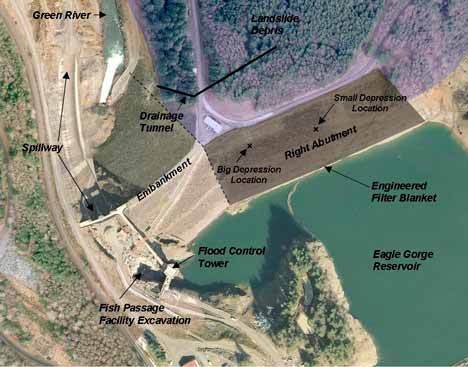The U.S. Army Corps of Engineers plans to construct a grout curtain by November to slow the water leaking through a damaged abutment at the Howard Hanson Dam.
The “curtain” is a semi-permeable barrier that would help slow the flow of the water coming out of the damaged structure.
But even with that interim fix, corps officials will not be able to store as much water behind the dam as in previous years. Any long-term fix, such as construction of a concrete cutoff wall, remains at least a few years away.
“A concrete wall would take much longer to construct,” said Col. Anthony Wright, commander of the Seattle district of the Army Corps, at a Monday briefing in Seattle to elected officials and emergency managers from King County, Kent, Renton, Auburn and Tukwila. “We’re looking to get something done by flood season.”
The Corps will spend about $8.8 million to install the grout curtain. Construction starts this month. Crews will drill holes and pump in grout to form a two-layer barrier of about 450 feet long and 160 feet deep.
“It will result in a low-permeable barrier,” Wright said. “We’re not trying to stop all of the water, but to control it and monitor it.”
Wright would like to have full-storage capacity of 1,206 feet in the reservoir behind the dam. The pool level reached 1,189 feet during the storm last January.
Dye testing last month showed that water is moving through the right abutment very fast at pool elevations above 1,155 feet.
“This is an interim measure,” Wright said of the grout curtain. “It should improve the effectiveness and safety of the dam incrementally.”
With construction of the grout curtain expected to be finished just before flood season starts in November, Corps officials will not be able to test the curtain until next spring.
“We don’t want a full pool, have rain hit and then not have the capacity for storage,” Wright said.
Corps officials plan to spend as much as $3 million to study whether a concrete cutoff wall would be the best permanent fix. Construction of a cutoff wall could start in 2011 and would cost in the “hundreds of millions of dollars,” Wright said.
“We don’t know the best answer,” Wright said of a permanent fix. “If we assume it’s a cutoff wall, it would take a couple of years to do and be very expensive. That appears to be the direction we’re going. But we need to study it to find out what makes the most sense.”
The problems with water storage behind the dam started when a 10-foot-wide depression formed on the embankment next to the dam after heavy rain in early January. The dam is about 20 miles east of Kent.
Flooding from the Green River could strike the cities of Kent, Auburn, Renton and Tukwila this winter if Corps officials store less water than normal behind the facility because of the damaged abutment. The federal government built the rock-and earth-fill dam in 1961 to control major flooding in the Green River Valley.
“It reduces the risk of flooding, but it doesn’t eliminate it,” Wright said of the dam. “The dam has done such a good job since 1962 that most people thought it eliminated the risk. There is still a reduced risk, but its effectiveness is much less than it was.”
Larry Blanchard, city of Kent public works director, attended the briefing and has been in constant contact with Corps officials to stay informed on what’s being done to combat flooding.
“It’s consistent with what they have been looking at with their approach and analysis of the situation,” Blanchard said after the meeting. “They realize there is a short-term potential solution and at the same time are looking at a long-term solution. The cement wall might be the long-term approach.”
Wright told the elected officials he expects to be able to give them as much as 24 to 36 hours of notice next winter of a potential flood event. Local officials would decide what type of emergency steps to take, including the possible evacuation of residents.
Wright emphasized that property owners in the Green River Valley need to look into buying flood insurance. Once someone buys a policy, it takes 30 days to become effective.
For more information, go to www.kingcounty.gov/floodplans or www.nws.usace.army.mil. Click on National Flood Insurance Program on the county site for property searches on flood risk and insurance rates.
Talk to us
Please share your story tips by emailing editor@kentreporter.com.
To share your opinion for publication, submit a letter through our website https://www.kentreporter.com/submit-letter/. Include your name, address and daytime phone number. (We’ll only publish your name and hometown.) Please keep letters to 300 words or less.

